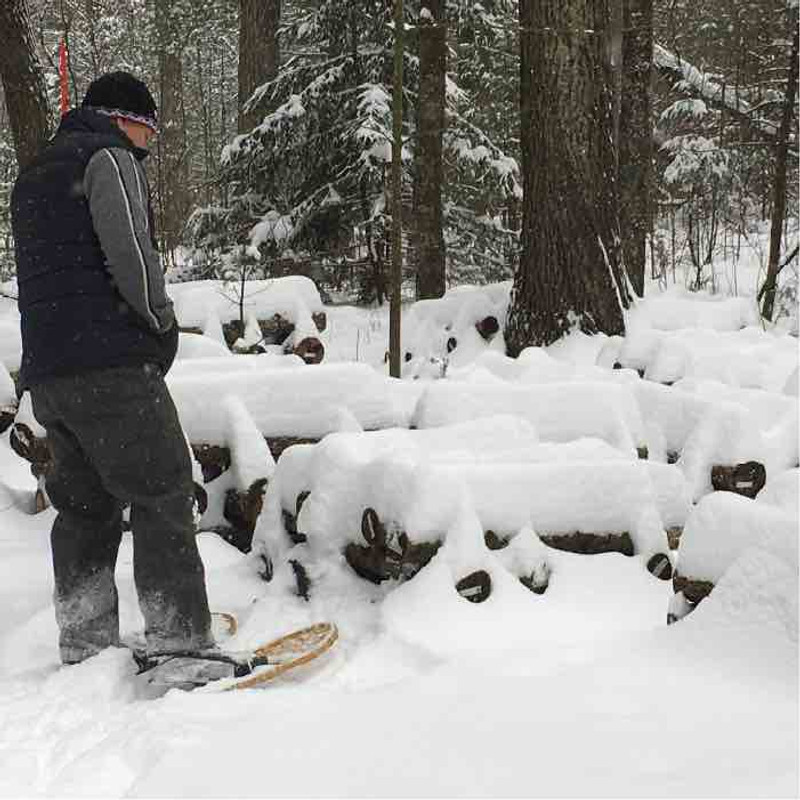Overall, mushroom logs are pretty tough once they are fully colonized. Logs that were inoculated in the spring or the previous year should come through a severe winter unscathed if the logs are properly stacked. Even newly inoculated logs, if properly stacked, can hunker down into a holding phase during the deep freeze and resume growth in the spring.
When choosing an appropriate stacking configuration, you will take into account the strain, age and overall health of the log, the severity of your winters and how protected your Shiitake yard is. With all stacking methods, there is no need to tarp the logs during the winter because the logs benefit from access to rain and snowfall. When logs are covered with a non-permeable tarp overheating and condensation can occur, encouraging competitor fungi.
Stacking Configuration Guidelines
1. Low Lean-To Stack: In climates with severe winters, keeping the logs low to the ground can protect them from freeze-drying winds by a blanket of snow. Logs bundled together and stacked close to the ground get minimum wind exposure. This stack is especially good for logs you've just inoculated this fall or if you have particularly harsh winters.

2. Open Low Lean-To Stack: For northern areas that have a lot of space in the mushroom yard, you can also try an Open Low Lean-To Stack. This is identical to the low lean-to but there are fewer logs in the course. This useful stack can be used as your primary stack immediately after inoculation in the spring, no need to re-stack to get ready for winter because the logs had all summer to colonize. The open stack also allows for easy harvest of natural fruiting early spring and late fall and can stay in this configuration permanently.

3. High Lean-To Stack: In areas that have milder winters, try a High Lean-To Stack. This is the same concept as the Low Lean-To except in gentler climates, logs don't need to be so low to the ground, and can be stacked at a higher angle, facilitating drainage of excess rain.

4. Crib Stack: If you are short on space, try a Crib Stack. In cold, snowy areas, stack the logs in a Low Crib Stack, constructed in tight layers, with the larger diameter logs placed at the outer edges. Try not to stack taller than knee-high to keep the logs protected. This is also a good stack for newly inoculated logs, as is the Low-Lean-To Stack.

5. Open Crib Stack: Growers in mild winter climates will often just use an Open Crib Stack and often do not need to adjust the stack for winter storage because they get plenty of rain and the temperatures are not so severe. At Field and Forest Products, we allow our logs that have been in production for over a year or more to stay in moderately high crib stack through the winter because the labor trade off to re-stack the logs just for winter-time is just too great. Plus, older logs can benefit from drying out a little during the winter.

6. A-Frame Stack: Possibly only mild weather climates should use the A-Frame Stack for winter storage, and should be used only with logs that are well colonized and have seen at least a season of good production. This stack is prone to drying and collapsing unless you are a master-stacker and have constructed a sound stacking frame.
Do you need to cover your logs?
Though it may seem counterintuitive, blow the leaves off stacks to prevent excessively moist bark surfaces in the spring which can lead to surface molds. The same could be accomplished by opening up tight low lean to's that have accumulated leaves to fall onto the forest floor. Also, avoid tarping logs with blankets or plastic unless they are carefully monitored for the winter. You want that extra winter moisture but also want to avoid overheating and condensation on the wood on warm winter days!
One thing that you can do if your logs are in a more exposed area is to cover your logs with pine boughs or other similar materials that allow the logs to breathe but still have some extra protection against the wind.
Most mushrooms that are cultivated are well adapted to very cold weather. A little TLC to avoid the combination of cold and wind will allow your logs to safely lay down for a cold winter's nap.


